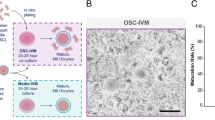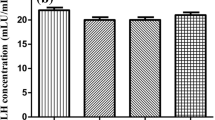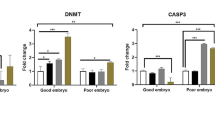Abstract
The study examines the effect of in vitro cultivation of mouse embryos for 48 h with 200 µM linoleic acid (LA) on their viability after vitrification. Fluorescence microscopy of DAPI-stained embryos showed increased fragmentation of nuclei in case of exposure to LA without cryopreservation and a significant decrease in the number of cells in vitrified embryos 24 h after their thawing. Thus, in vitro cultivation with LA reduces the viability of mouse embryos after vitrification.
Similar content being viewed by others
REFERENCES
Amstislavsky, S., Mokrousova, V., Brusentsev, E., Okot-rub, K., and Comizzoli, P., Influence of cellular lipids on cryopreservation of mammalian oocytes and preimplantation embryos: a review, Biopreserv. Biobanking, 2019, vol. 17, pp. 76–83. https://doi.org/10.1089/bio.2018.0039
Arena, R., Bisogno, S., Gasior, L., et al., Lipid droplets in mammalian eggs are utilized during embryonic diapause, Proc. Natl. Acad. Sci. U. S. A., 2021, vol. 118. art. e2018362118. https://doi.org/10.1073/pnas.2018362118
Dias, L., Leme, L., Spricigo, J., Pivato, I., and Dode, M., Effect of delipidant agents during in vitro culture on the development, lipid content, gene expression and cryotolerance of bovine embryos, Reprod. Domest. Anim., 2020, vol. 55, pp. 11–20. https://doi.org/10.1111/rda.13579
Dunning, K., Russell, D., and Robker, R., Lipids and oocyte developmental competence: the role of fatty acids and b-oxidation, Reproduction. 2014, vol. 148, pp. 15–27. https://doi.org/10.1530/REP-13-0251
Hochi, S., Kimura, K., and Hanada, A., Effect of linoleic acid-albumin in the culture medium on freezing sensitivity of in vitro-produced bovine morulae, Theriogenology, 1999, vol. 52, pp. 497–504. https://doi.org/10.1016/S0093-691X(99)00146-6
Igonina, T.N., Okotrub, K.A., Brusentsev, E.Yu., et al., Alteration of the lipid phase transition during mouse embryos freezing after in vitro culture with linoleic acid, Cryobiology, 2021, vol. 99, pp. 55–63. https://doi.org/10.1016/j.cryobiol.2021.01.014
Lapa, M., Marques, C., Alves, S., et al., Effect of trans-10 cis-12 conjugated linoleic acid on bovine oocyte competence and fatty acid composition, Reprod. Domest. Anim., 2011, vol. 46, pp. 904–910. https://doi.org/10.1111/j.1439-0531.2011.01762.x
Nonogaki, T., Noda, Y., Goto, Y., Kishi, J., and Mori, T., Developmental blockage of mouse embryos caused by fatty acids, J. Assist. Reprod. Genet., 1994, vol. 11, pp. 482–488. https://doi.org/10.1007/BF02215713
Pereira, R. and Marques, C., Animal oocyte and embryo cryopreservation, Cell Tissue Bank, 2008, vol. 9, pp. 267–277. https://doi.org/10.1007/s10561-008-9075-2
Tatsumi, T., Takayama, K., Ishii, S., et al., Forced lipophagy reveals that lipid droplets are required for early embryonic development in mouse, Development, 2018, vol. 145, art. dev161893. https://doi.org/10.1242/dev.161893
Walther, T. and Farese, R., Lipid droplets and cellular lipid metabolism, Annu. Rev. Biochem., 2012, vol. 81, pp. 687–714. https://doi.org/10.1146/annurev-biochem-061009-102430
Welte, M. and Gould, A., Lipid droplet functions beyond energy storage, Biochim. Biophys. Acta, 2017, vol. 1862, pp. 1260–1272. https://doi.org/10.1016/j.bbalip.2017.07.006
ACKNOWLEDGMENTS
The authors express their gratitude to the Center for Genetic Resources of Laboratory Animals Shared-Access Center (http://spf.bionet.nsc.ru) and the Shared-Access Center for Microscopic Analysis of Biological Objects (Institute of Cytology and Genetics, Siberian Branch, Russian Academy of Sciences) (http://www.bionet.nsc.ru/microscopy).
Funding
The work was performed with the support of Russian Foundation for Basic Research, no. 19-016-00025, budget project no. 0259-2021-0015 with the usage of equipment of the Center for Genetic Resources of Laboratory Animals Shared-Access Center of the FRC Institute of Cytology and Genetics (Siberian Branch, Russian Academy of Sciences) supported by the Ministry of Science and Higher Education of Russia (Unique project ID is RFMEFI62119X0023).
Author information
Authors and Affiliations
Contributions
E.Yu. Brusentsev, T.N. Igonina, and S.Ya. Amstislavsky developed the design of the experiment. E.Yu. Brusentsev, T.N. Igonina, and S.V. Okotrub obtained preimplantation embryos, carried out their vitrification and thawing, and their cultivation in vitro. E.A. Chuyko carried out DAPI staining, counting the number of interphase nuclei, their fragments, and metaphase plates in developing blastocysts. E.Yu. Brusentsev, T.N. Igonina, S.V. Okotrub, and S.Ya. Amstislavsky participated in data analysis. E.Yu. Brusentsev, T.N. Igonina, and S.Ya. Amstislavsky participated in writing the text of the article. All the authors participated in the discussion of the results.
Corresponding author
Ethics declarations
Conflict of interest. The authors declare that they have no conflict of interests.
Statement on the welfare of animals. In the course of implementing this study, all manipulations performed with experimental animals, methods of anesthesia, euthanasia, and animal care before and after experimental interventions complied with international standards of bioethics.
Additional information
Translated by A. Ermakov
Rights and permissions
About this article
Cite this article
Brusentsev, E.Y., Igonina, T.N., Okotrub, S.V. et al. Effect of Linoleic Acid on the Efficiency of Mouse Embryos’ Vitrification. Russ J Dev Biol 53, 51–54 (2022). https://doi.org/10.1134/S1062360422010027
Received:
Revised:
Accepted:
Published:
Issue Date:
DOI: https://doi.org/10.1134/S1062360422010027




